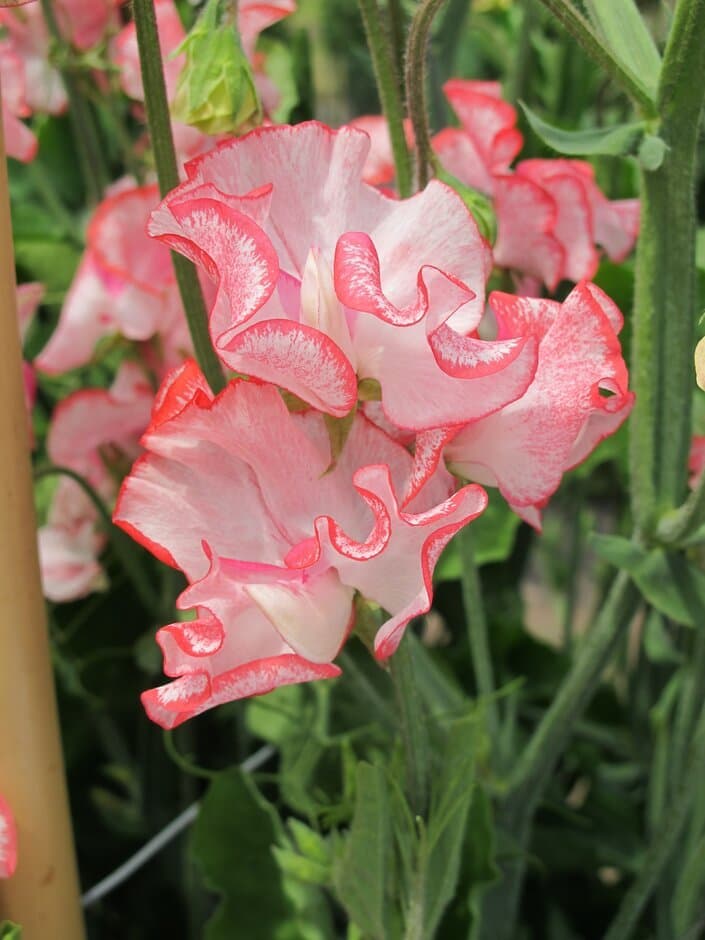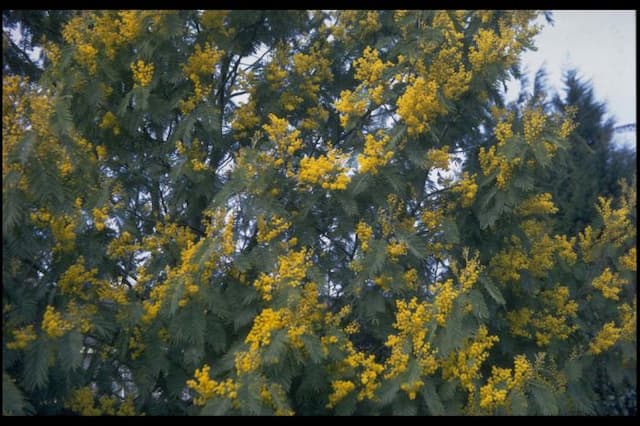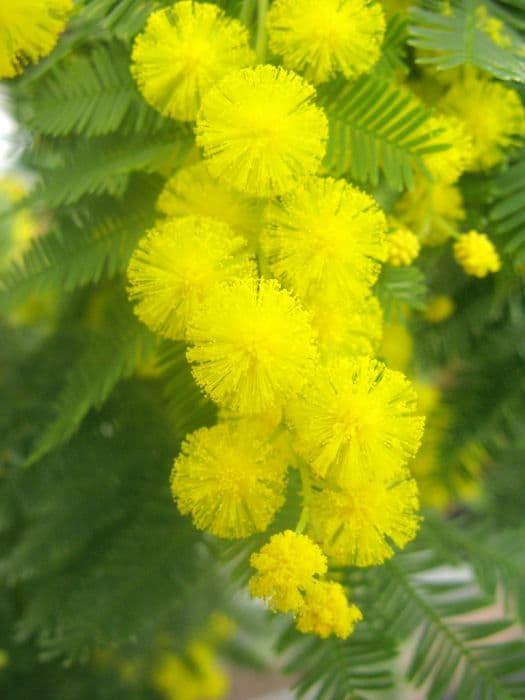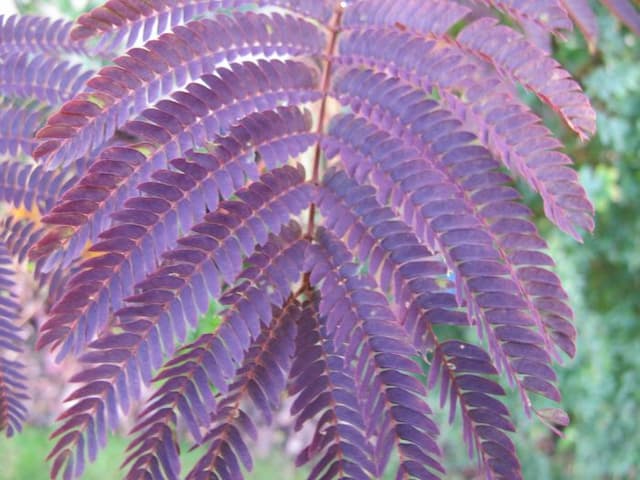Sweet pea Lathyrus odoratus 'Minuet Orange-pink'

ABOUT
Sweet pea 'Minuet Orange-pink' is a captivating variety that exudes old-world charm through its distinctive flowers. The blossoms present a harmonious blend of orange and pink hues, creating a warm and inviting appearance. Each flower bears a traditional sweet pea shape, with a standard, or banner, petal at the back and two wing petals on each side, enveloping the keel petals in the center. The flowers often offer a sweet, enchanting fragrance, a signature trait of sweet peas. The petals have a delicate, velvety texture and may display subtle variations in color intensity, giving them a romantic, soft look. This variety of sweet pea typically produces abundant blooms that gracefully adorn the green tendrils and foliage. The leaves are comprised of pairs of leaflets, with a terminal tendril used to climb and support the plant as it grows.
About this plant
 Names
NamesFamily
Fabaceae
Synonyms
Sweet Pea, Everlasting Pea, Perennial Pea, Peavine
Common names
Lathyrus odoratus.
 Toxicity
ToxicityTo humans
Sweet pea, including the variety 'Minuet Orange-pink,' is considered toxic due to the presence of a compound called beta-aminopropionitrile. The toxicity is mainly a concern when large amounts of the seeds are ingested. Chronic ingestion can lead to a condition known as lathyrism, which is characterized by neuromuscular symptoms such as weakness and paralysis of the lower limbs, as well as potentially irreversible neurological damage.
To pets
Sweet pea is also toxic to pets, including dogs and cats. The primary toxic agent, beta-aminopropionitrile, can cause similar symptoms in animals as it does in humans if ingested in large quantities. Pets might experience lethargy, weakness, pacing, tremors, seizures or convulsions, and even paralysis, particularly hindquarter paralysis. It's important to prevent pets from ingesting plant parts, particularly seeds, to avoid these severe and potentially debilitating effects.
 Characteristics
CharacteristicsLife cycle
Annuals
Foliage type
Deciduous
Color of leaves
Green
Flower color
Orange-pink
Height
6-8 feet (1.8-2.4 meters)
Spread
1-2 feet (0.3-0.6 meters)
Plant type
Climber
Hardiness zones
2-11
Native area
Mediterranean
Benefits
 General Benefits
General Benefits- Aesthetic Appeal: Lathyrus odoratus 'Minuet Orange-pink', commonly known as Sweet Pea, adds vibrant orange-pink blooms to gardens, offering a splash of color and enhancing visual interest.
- Fragrance: Sweet Pea is known for its delightful scent, which can perfume an entire garden space, creating a sensory experience for gardeners and visitors.
- Attracts Pollinators: The flowers attract bees, butterflies, and other beneficial insects, supporting pollination in the garden ecosystem.
- Easy to Grow: Sweet Pea is considered easy to grow and can be a good choice for beginner gardeners looking to add color and fragrance to their garden.
- Versatility: It can be used in various garden designs, such as borders, containers, and trellises, offering flexibility in landscaping.
- Cut Flowers: The blooms of Sweet Pea make excellent cut flowers for vases and arrangements, allowing enjoyment of their beauty indoors.
- Screening: When grown on supports, Sweet Pea can create a natural screen, providing privacy and covering unsightly areas in the garden.
- Seasonal Interest: With a typical flowering season from late spring to summer, Sweet Pea brings seasonal interest to gardens during these months.
 Medical Properties
Medical PropertiesThis plant is not used for medical purposes.
 Air-purifying Qualities
Air-purifying QualitiesThis plant is not specifically known for air purifying qualities.
 Other Uses
Other Uses- As a natural dye: Sweet pea petals, especially in vibrant colors like 'Minuet Orange-pink', can be used to create natural dyes for fabrics or artworks.
- In perfumery: Due to its delightful fragrance, sweet pea flowers can be used in making homemade perfumes or scented sachets.
- Garden plant support: Growing sweet pea plants along fences or trellises can provide a living support structure for other climbing plants.
- Companion planting: Sweet peas can be grown alongside vegetables like beans, as they might deter certain pests due to their scent.
- Homemade potpourri: Dried sweet pea flowers can be used in creating aromatic potpourri mixes for home fragrance.
- Floral crafts: The stems and flowers of sweet peas can be used in floral crafts, including wreaths or table centerpieces.
- Educational use: The growth cycle of sweet peas can be used to teach children about plant biology and gardening basics.
- Decorative seed pods: After flowering, the ornamental seed pods can be dried and used in decorative arrangements or crafts.
- Culinary garnish: While not edible, the flowers can be used as a garnish for plating and presentation of dishes in high-end culinary settings.
- Artistic inspiration: The striking color of 'Minuet Orange-pink' sweet pea can serve as inspiration for artists in their color palettes and subject matter.
Interesting Facts
 Feng Shui
Feng ShuiSweet pea is not used in Feng Shui practice.
 Zodiac Sign Compitability
Zodiac Sign CompitabilitySweet pea is not used in astrology practice.
 Plant Symbolism
Plant Symbolism- Delicate Pleasure: Sweet pea, as Lathyrus odoratus is commonly known, embodies the joy and pleasure found in the simpler things of life, suggesting a delicate and pleasurable experience akin to its soft texture and pleasant fragrance.
- Goodbye and Departure: In the language of flowers, sweet pea has been used to express goodbyes or farewells, as it often signifies a wish for a pleasant departure and fond memories.
- Blissful Pleasure: Sweet pea's delightful scent and attractive blooms represent pure bliss and the pleasurable moments one experiences without the interference of everyday worries.
- Gratitude: Gifting sweet pea can indicate appreciation and thanks, making it a symbol for expressing gratitude towards another.
- Kindness: Because of its gentle appearance and fragrance, sweet pea is often associated with kindness, suggesting a tender and considerate nature.
 Water
WaterSweet peas require consistent moisture, especially when they are blooming. Water the Lathyrus odoratus 'Minuet Orange-pink' deeply once a week, providing about 1 inch of water each time. During periods of drought or particularly hot weather, you may need to water twice a week to maintain soil moisture. Avoid overhead watering to prevent mildew and other fungal diseases, and instead use a soaker hose or water directly at the base of the plant. It's crucial to never let the soil dry out completely, as sweet peas are sensitive to drying.
 Light
LightSweet peas, such as Lathyrus odoratus 'Minuet Orange-pink', thrive in full sun conditions, which means they require at least 6 to 8 hours of direct sunlight each day. Plant them in a spot that gets plenty of morning sunlight, which is gentler on the plants, yet still offers enough light for healthy growth. They can tolerate partial shade, but their blooming may be reduced in less light.
 Temperature
TemperatureSweet peas prefer cooler temperatures and Lathyrus odoratus 'Minuet Orange-pink' will flourish when daytime temperatures are between 55 and 65 degrees Fahrenheit. They can survive minimum temperatures down to 25 degrees Fahrenheit but prefer not to be subjected to hard frosts. The ideal growing conditions include cool nights and temperate days, which prolong the flowering period.
 Pruning
PruningPruning promotes vigorous growth and blooming in Lathyrus odoratus 'Minuet Orange-pink', commonly known as sweet peas. Pinch off the tips when the plants are 4 to 6 inches tall to encourage bushy growth. Deadhead spent blossoms regularly to encourage continued flowering. The best time for pruning sweet peas is during the cool part of the day, and it should be done throughout the blooming season.
 Cleaning
CleaningAs needed
 Soil
SoilSweet pea 'Minuet Orange-pink' thrives in rich, well-draining soil with a pH range of 6.0 to 7.5. A mix of loamy soil with compost and a slow-release fertilizer is ideal for nutrition and growth.
 Repotting
RepottingSweet peas, including 'Minuet Orange-pink', usually do not require repotting as they are annual plants that complete their life cycle within one growing season and are typically sown directly where they are to flower.
 Humidity & Misting
Humidity & MistingSweet pea 'Minuet Orange-pink' prefers moderate humidity levels and does not require any special humidity adjustments when grown outside in its natural environment.
 Suitable locations
Suitable locationsIndoor
Ensure bright light, cool temps, and support for vines.
Outdoor
Needs full sun, cool roots, support for climbing, well-drained soil.
Hardiness zone
2-11 USDA
 Life cycle
Life cycleThe life cycle of the Sweet pea 'Minuet Orange-pink' begins with seed germination, which typically occurs in cool, early spring conditions or after a period of winter cold stratification. After germination, the plant starts vegetative growth, developing leaves and a vining stem that seeks out support to climb. During the vegetative stage, it will also develop a robust root system. As the weather warms up, it enters the flowering stage, producing fragrant, orange-pink flowers that attract pollinators. After pollination, the flowers will develop into pods, setting seeds for the next generation. Finally, as temperatures drop or conditions become less favorable, the plant will die back, completing its annual life cycle, unless it is in an environment that allows it to overwinter and behave as a perennial.
 Propogation
PropogationPropogation time
Spring to early summer
The Sweet Pea 'Minuet Orange-pink' is typically propagated by seed sowing. The optimal time for sowing Sweet Pea seeds is either in late fall or early spring, depending on the local climate and the desired blooming period. To propagate by seed, one should initially soak the seeds in water for 24 hours to soften the hard outer shell and promote germination. Afterwards, the seeds are sown about an inch deep (approximately 2.5 cm) in well-draining soil and spaced about 2 inches apart (approximately 5 cm). Provide consistent moisture and keep the environment at about 55 to 65 degrees Fahrenheit (13 to 18 degrees Celsius) to ensure germination, which typically occurs within 10 to 14 days. Once the seedlings are a few inches tall, they can be thinned out or transplanted to their final growing location. It's important to provide a support structure for the climbing vines as they grow.









